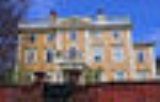
Nightingale-Brown House
Encyclopedia
The Nightingale–Brown House is a National Historic Landmark
at 357 Benefit Street in Providence
, Rhode Island
, United States
, that is home to the John Nicholas Brown Center for Public Humanities and Cultural Heritage at Brown University
.
In 1792 Captain Joseph Nightingale built the house. In 1814 Nicholas Brown, Jr.
purchased the home. His descendants owned the house until the death of Anne S.K. Brown in 1985, at which point it was donated to Brown University. Architects Thomas Tefft and Richard Upjohn
made additions in 1853 and 1864, respectively. Frederick Law Olmstead landscaped the grounds in 1890.
The site was declared a National Historic Landmark
in 1989.
It is included in the College Hill Historic District.
National Historic Landmark
A National Historic Landmark is a building, site, structure, object, or district, that is officially recognized by the United States government for its historical significance...
at 357 Benefit Street in Providence
Providence, Rhode Island
Providence is the capital and most populous city of Rhode Island and was one of the first cities established in the United States. Located in Providence County, it is the third largest city in the New England region...
, Rhode Island
Rhode Island
The state of Rhode Island and Providence Plantations, more commonly referred to as Rhode Island , is a state in the New England region of the United States. It is the smallest U.S. state by area...
, United States
United States
The United States of America is a federal constitutional republic comprising fifty states and a federal district...
, that is home to the John Nicholas Brown Center for Public Humanities and Cultural Heritage at Brown University
Brown University
Brown University is a private, Ivy League university located in Providence, Rhode Island, United States. Founded in 1764 prior to American independence from the British Empire as the College in the English Colony of Rhode Island and Providence Plantations early in the reign of King George III ,...
.
In 1792 Captain Joseph Nightingale built the house. In 1814 Nicholas Brown, Jr.
Nicholas Brown, Jr.
Nicholas Brown, Jr. , was a Providence, Rhode Island businessman and philanthropist who was the namesake of Brown University.-Biography:...
purchased the home. His descendants owned the house until the death of Anne S.K. Brown in 1985, at which point it was donated to Brown University. Architects Thomas Tefft and Richard Upjohn
Richard Upjohn
Richard Upjohn was an English-born architect who emigrated to the United States and became most famous for his Gothic Revival churches. He was partially responsible for launching the movement to such popularity in the United States. Upjohn also did extensive work in and helped to popularize the...
made additions in 1853 and 1864, respectively. Frederick Law Olmstead landscaped the grounds in 1890.
The site was declared a National Historic Landmark
National Historic Landmark
A National Historic Landmark is a building, site, structure, object, or district, that is officially recognized by the United States government for its historical significance...
in 1989.
It is included in the College Hill Historic District.

